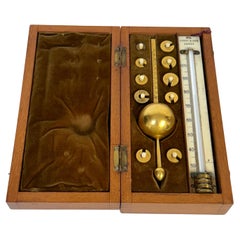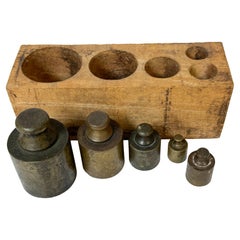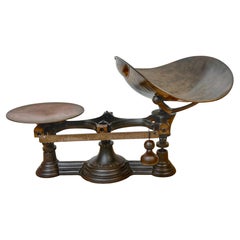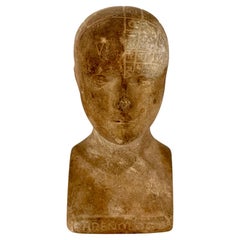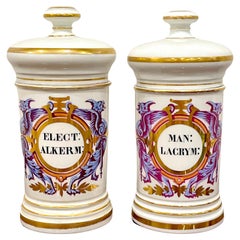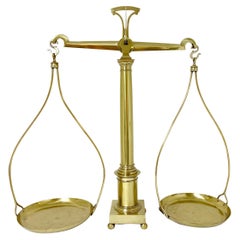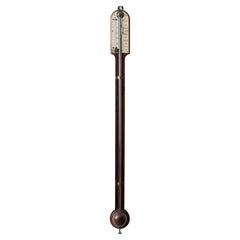Grinard Collection Scientific Instruments
to
4
7
7
2
2
1
1
1
1
6
5
2
2
2
1
6
3
2
2
1
7
7
7
1
1
Rare Sikes’ Hydrometer (Alcohol Proof Tester) Set Atkey & Son, Cowes, C. 1830
Located in West Palm Beach, FL
Sikes’ Hydrometer Set by Atkey & Son, Cowes, Circa 1830
A superb and complete 19th-century Sikes’ hydrometer set, by Atkey & Son of Cowes, a noted English maker of fine scientific i...
Category
Antique Early 19th Century English Regency Scientific Instruments
Materials
Brass
Five 19th C. French Bronze Metric (Apothecary ) Weights, Original Wooden Block
Located in West Palm Beach, FL
Set of 5 Antique French Bronze (Apothecary) Metric Weights with Original Wooden Block, Circa 1880
A handsome and authentic set of 19th-century French bronze metric weights, housed i...
Category
Antique Late 19th Century French Industrial Scientific Instruments
Materials
Bronze
Henry Troemner Apothecary Cast Iron & Metal Balance Scale #1, Circa 1890s
By Henry Troemner
Located in West Palm Beach, FL
Henry Troemner Apothecary Cast Iron & Metal Balance Scale #1—Circa 1890s
This Henry Troemner balance scale #1 is a remarkable antique cast iron scale, likely manufactured between th...
Category
Antique Late 19th Century American High Victorian Scientific Instruments
Materials
Metal, Iron
19th C. Diminutive Plaster Phrenology Head, Atribb. A.L. Vago London, C.1870
By Vago
Located in West Palm Beach, FL
19th C. Diminutive Plaster Phrenology Head, Attributed to A.L. Vago London. C 1870
This diminutive plaster Phrenology head, attributed to A.L. Vago London circa 1870, stands as a f...
Category
Antique 19th Century English High Victorian Scientific Instruments
Materials
Plaster
$920 Sale Price
20% Off
Pair of Neoclassical Apothecary Jars by Maison A Collin Porcelaines & Cristaux
By Old Paris
Located in West Palm Beach, FL
Pair of Neoclassical Apothecary Jars by Maison A Collin Porcelaines & Cristaux
France, Circa 1870s
Signed : Maison A Collin Porcelaines & Cristaux a Collin paris 90 Rue de Rivoli
We...
Category
Antique 19th Century French Neoclassical Scientific Instruments
Materials
Porcelain
$1,196 Sale Price / set
20% Off
Large Antique French Neoclassical Brass Scale
Located in West Palm Beach, FL
Large Antique French Neoclassical Brass Scale, by Berenger & Co, Lyon
France, Circa 1870
A stunning Large Antique French Neoclassical Brass Scale, crafted by the renowned Berenger & Co of Lyon during the mid to late 19th Century. This remarkable brass shop keepers, assay or pharmacist scale...
Category
Antique Late 19th Century French Neoclassical Scientific Instruments
Materials
Brass
$2,280 Sale Price
20% Off
Substantial Antique Italian Bronze Mortar and Pestle
Located in West Palm Beach, FL
Substantial antique Italian bronze mortar and pestle, finely cast with shell and floral band, complete with 12" x 1.5" D pestle. The base of t...
Category
Antique 18th Century Italian Baroque Scientific Instruments
Materials
Bronze
$1,020 Sale Price / set
20% Off
Related Items
Beautiful Glass Apothecary Jar - price per piece
Located in Brussels, BE
Cut-glass top and blown glass jar beautiful quality.
Multiple available
Category
20th Century European Jars
Materials
Blown Glass, Cut Glass
English Stick Barometer by Loftus, London, 19th Century
Located in Savannah, GA
A late 19th century rosewood stick barometer by Loftus of London.
3 ¼ inches wide by 36 inches tall; 3 inches deep
Category
Antique 19th Century English Scientific Instruments
Materials
Rosewood
Rare 19th Century English Tunbridgeware Hair Pin or Slide
Located in Dallas, TX
PRESENTING an EXTREMELY UNIQUE and RARE 19C British Tunbridgeware Hair Pin/Bobbin or Slide.
This slide is unlike any of it’s kind we have seen before, it is a VERY RARE survivor.
From circa 1860 – 80 and made in Tunbridge Wells, England.
Made of walnut with gorgeous marquetry inlay on the entirety of the front with classic Tunbridgeware micro-mosaic all over the front. The rear is walnut.
The marquetry inlay appears to be various different woods, namely, maple, walnut and satinwood.
Would have been worn in a Lady’s hair bun with the micro-mosaic facing forward.
This would have belonged to a VERY ELEGANT LADY in the mid to late 19th Century.
Tunbridge ware is a form of decoratively inlaid woodwork, typically in the form of boxes, that is characteristic of Tonbridge and the spa town of Royal Tunbridge Wells in Kent in the 18th and 19th centuries. The decoration typically consists of a mosaic of many very small pieces of different coloured woods that form a pictorial vignette. Shaped rods and slivers of wood were first carefully glued together, then cut into many thin slices of identical pictorial veneer with a fine saw. Elaborately striped and feathered bandings for framing were pre-formed in a similar fashion.
There is a collection of Tunbridge ware in the Tunbridge Wells Museum and Art Gallery in Tunbridge Wells.
The famous makers of Tunbridge ware were in the Tunbridge Wells area of Kent; their most notable work was from circa 1830-1900.
Early makers of Tunbridge ware, in Tunbridge Wells in the mid-18th century, were the Burrows family, and Fenner and Co. In the 19th century, around 1830, James Burrows invented a technique of creating mosaics from wooden tesserae. Henry Hollamby, apprenticed to the Burrows family, set up on his own in 1842 and became an important manufacturer of Tunbridge ware, employing about 40 people.
Edmund Nye (1797–1863) and his father took over the Fenner company when William Fenner retired in 1840, after 30 years in partnership with him. Thomas Barton (1819–1903), previously apprenticed at the Wise factory, joined the Nyes in 1836, and worked as Nye’s designer; he took over the business in 1863 and continued there until his death.
In Tonbridge (near to Tunbridge Wells), George Wise (1703–1779) is known to have had a business in 1746. It continued with his son Thomas, and Thomas’s nephew George (1779–1869), who took over in 1806. In its early years the company made articles such as workboxes and tea caddies with prints of popular views; later items had pictures created from mosaics. Their workshop in Tonbridge, Wise’s Tunbridge Ware Manufactory, was next to the Big Bridge over the Medway; the building was demolished in 1886 to widen the approach to the bridge.
Tunbridge ware became popular with visitors to the spa town of Tunbridge Wells, who bought them as souvenirs and gifts. Articles included cribbage boards, paperweights, writing slopes, snuffboxes and glove boxes.
At the Great Exhibition of 1851, Tunbridge ware by Edmund Nye, Robert Russell and Henry Hollamby was shown; Edmund Nye received a commendation from the judges for his work. He exhibited a table depicting a mosaic of a ship at sea; 110,800 tesserae were used in making the picture.
The manufacturers of Tunbridge ware were cottage industries, and they were no more than nine in Tunbridge Wells and one in Tonbridge. The number declined in the 1880s; competent craftsmen were hard to find, and public tastes changed. After the death of Thomas Barton in 1903 the only surviving firm was Boyce, Brown and Kemp, which closed in 1927.
Marquetry was an old technique which was continued by Nye and Barton to create images such as birds or butterflies.
‘Green Oak’ as caused by the fungus Chlorociboria aeruginascens.
Stickware and half-square mosaic was invented by James Burrows in about 1830: a bunch of wooden sticks of different colours, each having triangular or diamond-shaped cross section, were tightly glued together; in the case of stickware, the resulting block was dried, then turned to form an article such as the base of a pincushion. For half-square mosaic, thin slices were taken from the composite block, and applied to a surface.
Tesselated mosaic, was a development by James Burrows of half-square mosaic; it was adopted by George Wise and Edmund Nye. Minute tesserae were used to form a wide variety of geometric and pictorial designs.
Many sorts of wood were used for the various colours; about 40 were in regular use. Only natural colors were used; green was provided by “green oak”, produced by the action of fungus on fallen oak. Designs for articles were often taken from designs of Berlin wool work.
Category
Antique Late 19th Century English High Victorian Collectible Jewelry
Materials
Satinwood, Walnut
Pair Of Cherry Smash Fountain Syrup Jars
Located in Essex, MA
Cherry Smash was a fountain syrup made from cherry syrup which soda jerks mixed with carbonated water. Founded in 1901 by John E. Fowler of Richmond Va. In...
Category
Early 20th Century American Historical Memorabilia
Materials
Metal
19th Century Italian Wood Mannequin, Circa 1870-1880
Located in Milano, IT
Mannequin
Sculpted and carved wood
Italy or France, second half of the 19th century.
It measures 25.59 x 6.29 x 3.54 in (65.5 x 16 x 9 cm)
It weighs 2.2 lb circa (1 kg circa)
St...
Category
Antique 1870s Italian Other Figurative Sculptures
Materials
Wood
Double Bronze/Brass Apothecary Scale
Located in Guaynabo, PR
This is a gilt bronze/brass double apothecary scale. It depicts an upside down bronze Corinthian column that holds two different set of balance brass ...
Category
20th Century Unknown Neoclassical Scientific Instruments
Materials
Marble, Bronze, Brass
19th Century Victorian Solid Silver Lighter & Vesta Case, London, c.1853
By Thornhill, Henry William Dee
Located in Royal Tunbridge Wells, Kent
Antique mid-19th Century very rare Victorian solid silver vesta case and lighter, in a shape of a horseshoe, opening on both sides, with a compartment for matches and a striker, with wheel to wind the lighter wick, one side is applied with initials "E.H". Hallmarked English Silver (925 standard), London, year 1853 (S), Maker's mark H.W.D (Henry William Dee...
Category
Antique 19th Century British Victorian Tobacco Accessories
Materials
Silver
$1,628
H 2.17 in W 2.17 in D 0.6 in
19th Century Bronze Pipe
Located in Copenhagen, K
Fantastic bronze pipe from the Vienna tobacco museum’s collection, from Belgian Congo.
Category
Antique 19th Century Congolese Folk Art Tobacco Accessories
Materials
Bronze
Bronze Weight, 18th Century
Located in Madrid, ES
Weight of the 18th century. Bronze.
Bronze weight, incomplete, with the container glass and two of the smallest, all decorated in cold with incised and...
Category
Antique 18th Century European Neoclassical Scientific Instruments
Materials
Bronze
Quad Electrostatic Loudspeakers, Rare Midcentury Modern Set Collectors Speakers
By Design Acoustics, Quad Manufacturing 1
Located in Antwerp, BE
The original ESL decorative pieces of art objects electrostatic speakers in its range in production between 1957 and 1985, has been hailed in Sound & Vision as one of the most import...
Category
Vintage 1960s English Mid-Century Modern Musical Instruments
Materials
Metal
$3,807
H 32.29 in W 34.26 in D 7.88 in
Set of 9 Antique Brass Scale Weights in Wood Block Apothecary 1920s
Located in Dayton, OH
1920's brass apothecary scale weight set including nine weights (one 50 gram, three 100 grams, one 200 grams, one 500 grams, one 1 kilo, and one 2 ki...
Category
Vintage 1920s Scientific Instruments
Materials
Brass
$280 Sale Price / set
20% Off
H 3.75 in W 4.25 in D 10.5 in
19th Century French Napoleon III Walnut and Brass Scale with Set of Weights
Located in Dallas, TX
This Classic, antique scale with original plates was created in Dijon France, circa 1870. Rectangular in shape, the fruit wood scale embellished with marquetry fillet decor, features...
Category
Antique Late 19th Century French Napoleon III Scientific Instruments
Materials
Brass
$1,300
H 10 in W 25 in D 10 in
